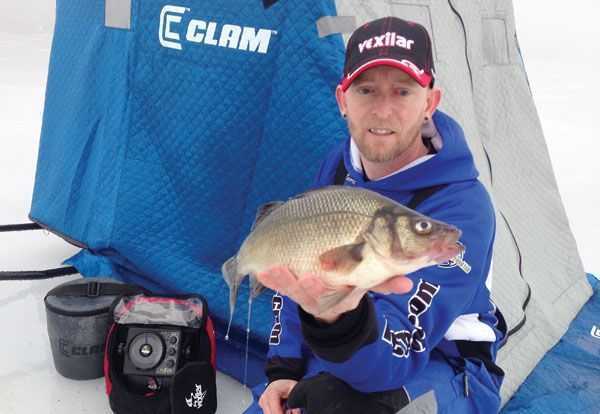Lake Winnipesaukee is one of New Hampshire’s most sought-after ice fishing destinations and one that should be on the bucket list of all anglers. Affectionately called “Winni,” or “the Big Lake,” this 71-square-mile lake has a maximum depth of 200 feet. Lake Winnipesaukee is an angler’s paradise. Lake trout, huge white perch, trophy-sized black crappie, pumpkinseeds, rainbow trout, and burbot can all be caught through the ice there. Seven of the thirty-five current state record fish were caught in Lake Winnipesaukee. However, figuring out where to fish can be the most challenging part of fishing New Hampshire’s big lake.
The best rule of thumb to follow when looking for panfish such as crappie or pumpkinseed is to head for the north end of the lake. Prior to icing over, north winds will push colder water to the south, leaving behind ever-so-slightly warmer water in the north. The difference in water temperature can be as little as one-half of a degree. That’s a big difference to warm-water species, and enough to keep them to the north. I have fished the north end of Winnipesaukee with great success. My biggest crappie to date were caught there, two 15 ½,” two-pound slabs.
I often target lake trout and white perch in the same trip, since both can be caught in some of the same areas. Determining which areas can be a daunting task. Since lake trout often prefer humps, while white perch often prefer inside turns, many anglers will choose to target one species or another. There are places however, where I have found both species: breaks or ledges. A steep break or ledge, in 30-40 feet of water, in or near a cove that has an inlet, is almost a sure thing when fishing for lake trout and white perch. The inlet will attract baitfish, which in Winnipesaukee are rainbow smelt, natural forage for both lake trout and white perch. During the day, but especially early and late, lake trout and white perch will chase smelt into ledges to feed on them. The lake trout will typically be found on the bottom and the white perch will usually feed suspended somewhere near the middle of the water column. Note that I said somewhere near the middle of the water column.
Electronics will play a huge part in how successful you are, especially since Lake Winnipesaukee has a two-line limit through the ice. Without electronics, you are left to setting your lines at only two depths. You may find yourself targeting one species or another. Since white perch move through in schools, and only stick around for a few minutes, I find a Vexilar sonar flasher to be the best tool, since it will display information in real-time and allow you to see your jig in relation to the fish. This way, if you are bottom-jigging for lake trout, and a school of white perch moves through suspended in the water column, you will know the perch are there and you can adjust your depth accordingly.
If I didn’t already live in New Hampshire, I would definitely be planning a trip to ice fish Lake Winnipesaukee. The diversity and abundance of fish is second to none and keeps my ice fishing clients coming back year after year. The panfish, lake trout, and white perch fishing are amazing! White perch and crappie in the two-pound range are caught on almost every trip I take and lake trout are often the star of the show. As always, keep safety first. If you are unfamiliar with the lake then take extra precautions and check as you go, but if you can, go with someone who knows the lake.
[easy-social-share]
